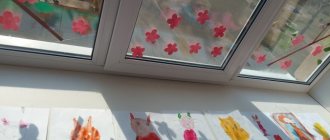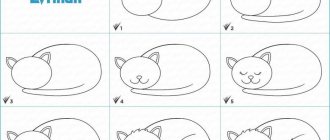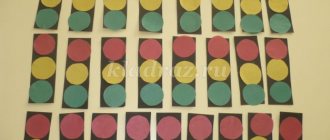Implementation of the program content in educational areas: “Cognitive development”; “Speech development.”
Types of children's activities: Cognitive and research, perception of fiction, communicative.
Goals: expand ideas about the capital of our Motherland - Moscow; introduce them to its sights, teach them to talk about what they learned and saw, and cultivate love for their native land and country.
Target guidelines for preschool education: knows and names the capital of Russia and the region, can tell about the sights of Moscow.
Progress of the lesson
Educator: What is the name of the country in which we live? What language do you and I speak? What is a country?
Children: “These are forests, seas, rivers, mountains, villages, cities...”
Educator: This is the place where we live, where your parents, grandparents, your acquaintances and friends lived. We call Russia our Motherland because we were born and raised. Everything here is dear to us. You and I have a small Motherland - your family, our kindergarten and our city - Bogotol. (The child recites a poem about the Motherland or family.)
Russia is a huge country and many people live in it. In order for there to be peace and order in the country, fair laws are needed that all people of the country would obey. The basic law of our state is the Constitution. The Constitution protects the rights of citizens and young citizens.
Every state has a main city - the capital. The capital of our Motherland is Moscow (I show it on the screen), and the capital of our Krasnoyarsk Territory is the city of Krasnoyarsk (I show it on the screen).
Educator: The main government institutions are located in Moscow - the parliament, where there is a State Duma and the Federation Council (I show the corresponding pictures on the screen), our president and the government of our country work in the Kremlin (ministers are assistants to the president, I show pictures).
The president is the head of state elected by the people. He and the government lead the country, decide important state issues, and approve laws.
Educator: Who knows the name of our president? (Children's answers.)
Educator: Moscow is the largest city in Russia. More than 8 million people live here. Now we will take an excursion to an exhibition of paintings in Moscow. It’s called “I’m Walking Around Moscow.”
Showing a picture (Moscow River and the Kremlin) Pay attention to the battlements and towers, they are made of red brick. One of the towers is Spasskaya, where the largest clock is located. We use them to check our time. There are many educational institutions in Moscow: universities, institutes, academies, where students from all over the world study and use the services of the central library (I show a picture of the central library).
I turn on the song “I am walking around Moscow” and do several exercises with the children (physical minute).
Educator: There are many churches in Moscow: the Annunciation Cathedral, the Archangel Cathedral, the Cathedral of Christ the Savior (I show the corresponding images on the screen).
There are many theaters in Moscow: the Academic Bolshoi Theater, the Maly Theater, and the Sergei Obraztsov Puppet Theater. There are also many squares (I show the corresponding images on the screen). There are also monuments to famous people who lived in this city: Pushkin, Mayakovsky, Tchaikovsky. There are many other attractions here: the Tsar Cannon, the fountain (I show the corresponding images on the screen).
Educator: There are many songs and poems about Moscow. Our children have prepared poems and sayings about Moscow (we listen to the children).
The history of Moscow, its centuries-old traditions, are reflected in the coat of arms of Moscow (I show the coat of arms), the flag, the anthem (I tell you what the flag is and what it means, and the anthem). If you have time left, you can draw the Russian flag.
Reflection: What new did you learn in class today? What did you like? (Children answer.)
Abstract of educational activities for cognitive development in the senior group “Moscow is the capital of Russia”
Summary of educational activities for cognitive development in the senior group
on the topic: “Moscow is the capital of Russia.”
Target. To deepen the knowledge of children in the capital of our Motherland - the city of Moscow.
Tasks.
To give an idea that Moscow is the most important city in our country.
Create interest in this city.
To evoke a feeling of admiration and pride for our capital.
Develop a respectful attitude towards your home country.
Visual material. Presentation./data/files/j1494704373.pptx (presentation about Moscow) Souvenirs.
Preliminary work. Reading stories and poems about the heroic city of Moscow, looking at illustrations about the sights of the city.
Move.
1 part. Near the window.
Educator: Guys, look outside the window, what do we see there? Children's answers.
— That’s right, outside the window you and I saw a piece of Parkovaya Street: houses, a road, a section of our group. Many of you live on Parkovaya Street, many, but not all. Tell me your home address and the streets on which you live. Children's answers.
- What do you think, if I want to write a letter to each of you and indicate the address you just named, will it reach the addressee?
The teacher summarizes the children's answers and says that in order for the mail to arrive, it is necessary to indicate the city to which the letter will be sent.
— What is the name of our hometown? That's right, Michurinsk, and for some time now a science city has been added to the word Michurinsk. That is, you and I live in the city of Michurinsk-science city.
While you are still small, Michurinsk is the most important city for you.
— What is the name of the most important city in our country for all Russians? This is Moscow, right. Why is Moscow the main city of our Country?
— Because Moscow is the capital of our Motherland.
Child:
There is a blue city on the planet, such a beautiful city, where the chiming clock strikes over the river. Everyone is infinitely dear to it.
Here, above the Kremlin wall, the Star burns and shines. My Moscow, my dear home Let everyone know about it.
Educator. Moscow is the largest and most beautiful city in Russia. More than 12,300,000 people live in Moscow. The capital differs from other cities in that the president and government of the country work there. Name the president of our country. This is Vladimir Vladimirovich Putin.
The capital of a state is often one of the oldest cities in the country. Moscow is an ancient city, the city is already 850 years old. Do you want to know about the history of Moscow?
Moscow was founded by Yuri Dolgoruky, who, looking at the nearby lands, ordered the construction of a wooden city on them. As a result of this, fortified wooden walls of the Kremlin were erected, which served to protect the inhabitants of nearby villages and new settlers, the construction of the prince's court and some other buildings. They called the fortress the Moscow principality.
— The history of Moscow is reflected in its coat of arms. Remind me what this is?
A coat of arms is a sign. All coats of arms are in the shape of a shield, because the shield protects against the enemy's spear and sword. The coat of arms of the city of Moscow appeared a very long time ago: this is evidenced by the clothing of the rider. This is how warriors dressed in ancient times. The Russian people often had to fight various enemies and therefore, by depicting a warrior on the coat of arms, the population wanted to say to all enemies: “Better not to attack us. We will defend our city and still win! What else do you see on the coat of arms? (Snake)
- What do you think it means? This is how the Russian people portrayed the enemy as terrible and evil. A Russian warrior kills a snake with a spear, and the horse tramples it with its hooves. The rider on the horse is not just a warrior, he is Saint George the Victorious. When Russian soldiers left to defend Moscow, people gathered in the church and prayed, asking for victory for their soldiers. People believed that Saint George could help the soldiers and prayed to him. Among the Russian people, St. George the Victorious is considered the guardian of Moscow, a defender from enemy attack.
— Every nation has not only a coat of arms, but also an anthem in which the people glorify their country, their city. Moscow also has such an anthem. The words for it were written by the poet Mark Lisyansky, and the music by the composer Isaac Dunaevsky. Let's listen to it, and who knows, you might sing along.
“I’ve walked around the world a lot”
I walked around the world a lot, I lived in a dugout, in the trenches, in the taiga, I was buried alive twice, I knew separation, I loved in melancholy. But I’m used to being proud of Moscow, and everywhere I repeated the words: My dear capital, my Golden Moscow! I love the groves near Moscow And the bridges over your river, I love your Red Square And the striking of the Kremlin chimes. In cities and distant villages, rumors about you will not cease, My dear capital, My golden Moscow!
And now you and I will relax, walk in the parade, and then take a tour of the city.
Physical education. At the parade.
Like soldiers on parade, We walk row by row, Left - once, left - once, Look at us, everyone. Everyone clapped their hands - Together, have fun! Our feet pounded louder and faster! (Walk in place.)
Part 2. “Excursion” around the city using the presentation “Moscow is the capital of Russia.”
Educator: Any journey begins when a person gets to the station of the city he arrived in. After all, the station building is the first thing that a visitor to the city will see, and therefore the station buildings in all cities are among the most beautiful. Our excursion will also begin from Moscow train stations. I didn’t mention exactly the stations, because there are a lot of stations in our capital. Various railway stations, river stations, airports.
— Why do you think there are so many stations? Because the capital must be connected with the whole country. Here are the Moscow stations in front of you: Kazansky, Kursky, Paveletsky, Belorussky, Rizhsky, Leningradsky, Savelovsky, Kyiv. Now look at the air gates of the capital: Sheremetyevo, Domodedovo, Vnukovo. In our Moscow there is also a river station - Severny. From the station, guests usually go to Red Square. The Kremlin, where the president and government work, is located here. A flag flies over government buildings - a symbol of state power. Name the colors of the Russian flag and what these colors mean.
— White color – peace and purity of conscience.
- Blue - sky, loyalty and truth.
— Red – fire and courage.
Pay attention to the Kremlin wall, its battlements and towers, there are many of them, but the main one is the Spasskaya Tower. On the Spasskaya Tower of the Kremlin there is the largest clock by which we check our time. Red Square is located in front of the Kremlin. There is a mausoleum, St. Basil's Cathedral, a monument to Minin and Pozharsky. Various events take place on this square: parades, demonstrations, folk festivals, a meeting of the first cosmonaut, a New Year tree. In 1941, troops marched across Red Square to defend Moscow. The enemy did not reach Moscow, and on May 9, 1945, a parade of our soldiers who defeated the enemy took place on the square. There are many theaters, concert halls, circus arenas, and monuments to famous people in Moscow. Here on the slide is a monument to A.S. Pushkin, whose fairy tales you know well. There are many streets and squares in Moscow. Cars of different brands rush through the streets, but the most interesting transport is the metro - an underground railway with many spacious and bright stations. By metro you can easily and quickly get to any point in the city.
Now let's play and check how you remember the information about our capital. Children are divided into two teams.
Name the capital of our Motherland.
Name the colors of the Russian flag.
Who is the founder of Moscow.
What is depicted on the Moscow coat of arms?
Name which train stations in the city you know.
Where is the Kremlin located?
What is the name of the tower on which the main clock of the country is located?
The most interesting transport in Moscow.
The teacher praises the children and gives out small souvenirs.
Bottom line. Guys, did you like Moscow? Children's answers. You have learned a lot of new and interesting things about the capital of our Motherland - the hero city of Moscow. You see how big, beautiful, majestic our capital is. When you grow up, you will definitely visit this city and get to know its sights yourself.





